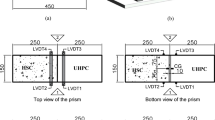Abstract
Cement paste hydration behavior and restrained shrinkage cracks were experimentally monitored using a non-contact electrical resistivity apparatus and a novel steel crack frame respectively. The electrical resistivity measurement indicates that all the curves followed similar trend and the lowest water cement ratio paste indicates highest resistivity values and reaches inflection point earliest. The restrained shrinkage crack test demonstrated that lower water cement ratio paste cracked earliest which therefore confirmed its highest crack tendency. The time upon which all the samples initiated cracks was not very long; hence the novel steel crack frame is proved effective and alternatively convenient method of ascertaining crack tendency of cement paste. A relationship has been developed between the highest inflection time of the tested samples and the corresponding crack time. Tensile strength test and ANSYS stress simulation were also performed; the results were plotted on one graph in which the intersection point of tensile strength and ANSYS stress of a particular sample predicts its crack time. The crack initiation ages obtained are consistent to the experimental results which indicate that ANSYS numerical analysis can also be utilised to predict the crack tendency of cement paste.
Similar content being viewed by others
References
ASTM-Standards (2009). “Standard test method for determining age at cracking and induced tensile stress characteristics of mortar and concrete under restrained Shrinkage.” C1581/C1581M–09a, DOI: 10.1520/C1581_C1581M-09A.
Beaudoin, J. J., Ping, G., and Myers, R. E. (1997). “Flexural strength of cement paste composites containing micron and sub-micron nickel particulates.” Cement and Concrete Research, Vol. 27, No. 1, pp. 23–27, DOI: 10.1016/S0008-8846(96)00182-2.
Frank, C. and Sanjayan, J. G. (2000). “Cracking tendency of alkaliactivated slag concrete subjected to restrained shrinkage.” Cement and Concrete Research, Vol. 30, No. 5, pp. 791–798, DOI: 10.1016/S0008-8846(00)00243-X.
Hu, Y. L. J. Y. Z., and Qi, P. (2013). “Flexural strength of cement paste beam under chemical degradation: Experiments and simplified modeling.” Journal of Material in Civil Engineering, Vol. 25, No. 5, pp. 555–562, DOI: 10.1061/(ASCE)MT.1943-5533.0000627.
Jun, Z., Dongwei, H., Yuan, G., and Sun, W. (2011). “Determination of moisture diffusion coefficient of concrete at early age from interior humidity measurements.” Drying Technology, Vol. 29, No. 6, pp. 689–696, DOI: 10.1080/07373937.2010.528106.
Khan, M., I. (2002). “Factors affecting the thermal properties of concrete and applicability of its prediction models.” Building and Environment, Vol. 37, No. 6, pp. 607–614, DOI: 10.1016/S0360-1323(01)00061-0.
Kim, K. H., Jeon, S. E., Kim, J. K., and Yang, S. (2003). “An experimental study on thermal conductivity of concrete.” Cement and Concrete Research, Vol. 33, No. 3, pp. 363–371, DOI: 10.1016/S0008-8846(02)00965-1.
Kovler, K., Sikuler, J., and Bentur, A. (1993). “Restrained shrinkage tests of fibre-reinforced concrete ring specimens: Effect of core thermal expansion.” Materials and Structures, Vol. 26, No. 4, pp. 231–237, DOI: 10.1007/BF02472616.
Mane, S. A., Desai, T. K., Kingsbury, D., and Mobasher, B. (2002). “Modeling of restrained shrinkage cracking in concrete materials.” American Concrete Institute, Vol. 206, pp. 219–242, DOI: 10.1.1. 515.3322.
Nailde de, A., orim C., Lineu J., P., João H., S., R., and Antônio, A., N. (2014). “Use of ANSYS for thermal analysis in mass concrete.” Journal of Civil Engineering and Architecture, Vol. 8, No. 7, pp. 860–868, DOI: 10.17265/1934-7359/2014.07.007.
Peeyush, C. and Ravi, K. S. (2013). “Effect of relative humidity on creep-shrinkage behaviour of composite tall buildings.” Latin American Journal of Solids and Structures, Vol. 10, No. 3, pp. 1679–7825, DOI: 10.1590/S1679-78252013000300007.
Peng, Z., Jin, X., and Jin, N. (2010). “Theoretical modeling of concrete moisture diffusion surface factor.” Earth and Space 2010: Engineering, Science, Construction, and Operations in Challenging Environments. American Society of Civil Engineers, pp. 3610–3616, DOI: 10.1061/41096(366)346.
Pongsak, C. and Somnuk, T. (2009). “A model for predicting the coefficient of thermal expansion of cementitious paste.” ScienceAsia, Vol. 35, No. 2009, pp. 57–63, DOI: 10.2306/scienceasia1513-1874.2009.35.057.
Sideris, K. K., Manita, P., and Sideris K. (2004). “Estimation of ultimate modulus of elasticity and poisson ratio of normal concrete,” Cement and Concrete Composite, Vol. 26, No. 6, pp. 623–631, DOI: 10.1016/S0958-9465(03)00084-2.
Su-Tae, K., Jeong-Su, K., Yun, L., Yon-Dong, P., and Jin-Keun, K. (2012). “Moisture diffusivity of early age concrete considering temperature and porosity.” Korean Society of Civil Engineers, Journal of civil engineering, Vol. 16, No. 1, pp. 179–188, DOI: 10.1007/S12205-012-1445-4.
Wei, D., Xiangming, Z., and Zhimin, W. (2014). “A fracture mechanicsbased method For prediction of cracking of circular and elliptical concrete rings under restrained shrinkage,” Engineering Fracture Mechanics, Vol. 131, pp. 687–701, DOI: 10.1016/j.enfracmech. 2014.10.015.
Wei, X. and Zongjin, L. (2006). “Early hydration process of portland cement paste by electrical measurement.” Journal of Materials in Civil Engineering, American Society of Civil Engineers, Vol. 18, No. 1, pp. 99–105, DOI: 10.1061/(ASCE)0899-1561(2006)18:1(99).
Wei, X., Xiao, L., and Li, Z. (2008). “Electrical measurement to assess hydration process and the porosity formation.” Journal of Wuhan University of Technology, Vol. 23, No. 5, pp. 761–766, DOI: 10.1007/S11595-007-5761-3.
Xiangming, Z., and Zongjin, L. (2007). “Numerical simulations of upsetting process of the fresh fiber-cement paste.” Journal of Engineering Mechanics, American Society of Civil Engineers, Vol. 133. No. 11, pp. 1192–1199, DOI: 10.1061/(ASCE)0733-9399(2007)133:11(1192).
Yishun, L., Xiaosheng, W., and Guowei, L. (2011). “Early hydration of calcium sulfoaluminate cement through electrical resistivity measurement and microstructure investigations.” Construction and building materials, Vol. 25. No, pp. 1572–1579, DOI: 10.1016/j.conbuidmat.2010.09.042.
Author information
Authors and Affiliations
Corresponding author
Rights and permissions
About this article
Cite this article
Bawa, S.M., Wei, X. & Wang, L. The relationship between electrical resistivity of cement paste and its restrained shrinkage crack with the aid of novel apparatus and ANSYS simulation. KSCE J Civ Eng 21, 339–345 (2017). https://doi.org/10.1007/s12205-016-0627-x
Received:
Revised:
Accepted:
Published:
Issue Date:
DOI: https://doi.org/10.1007/s12205-016-0627-x




